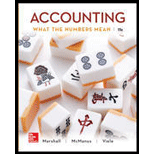
(A)
Concept Introduction:
Contribution margin ratio is defined as the portion of each sales dollar which is left after all variable costs are incurred and the amount is available to cover fixed cost to generate profits. It calculates change in contribution margin margin for every change in revenue. It is calculated as:
Contribution Margin Ratio = Contribution Margin/ Revenue.
Break Even Point is the amount of revenue realized where the firm will have neither profit nor loss. In other words, break even point is where operating profit is equal to zero.
The selling price of the new product if the average contribution margin ratio is not changed.
(B)
Concept Introduction:
Contribution margin ratio is defined as the portion of each sales dollar which is left after all variable costs are incurred and the amount is available to cover fixed cost to generate profits. It calculates change in contribution margin margin for every change in revenue. It is calculated as:
Contribution Margin Ratio = Contribution Margin/ Revenue.
Break Even Point is the amount of revenue realized where the firm will have neither profit nor loss. In other words, break even point is where operating profit is equal to zero.
The number of units required to be sold at break even point if fixed cost is added by $30600.
(C)
Concept Introduction:
Contribution margin ratio is defined as the portion of each sales dollar which is left after all variable costs are incurred and the amount is available to cover fixed cost to generate profits. It calculates change in contribution margin margin for every change in revenue. It is calculated as:
Contribution Margin Ratio = Contribution Margin/ Revenue.
Break Even Point is the amount of revenue realized where the firm will have neither profit nor loss. In other words, break even point is where operating profit is equal to zero.
Requirement 1:
The total operating income if 20000 new product units are sold at $13.75 per unit.
Requirement 2:
The average contribution margin ratio if 20000 new product units are sold at $13.75 per unit.
(D)
Concept Introduction:
Contribution margin ratio is defined as the portion of each sales dollar which is left after all variable costs are incurred and the amount is available to cover fixed cost to generate profits. It calculates change in contribution margin margin for every change in revenue. It is calculated as:
Contribution Margin Ratio = Contribution Margin/ Revenue.
Break Even Point is the amount of revenue realized where the firm will have neither profit nor loss. In other words, break even point is where operating profit is equal to zero.
Requirement 1:
Operating Income of existing product
Requirement 2:
The complications, if some volume from existing product is added to new product.
Want to see the full answer?
Check out a sample textbook solution
Chapter 12 Solutions
Accounting: What the Numbers Mean
- A cost is $5,600 at 1,000 units, $9,000 at 2,000 units, and $10,200 at 3,100 units. This cost is a __. A. mixed cost. B. fixed cost. C. step cost. D. variable cost.arrow_forwardNonearrow_forwardNiro Corp. is considering a new four-year expansion project that requires an initial fixed asset investment of $3.2 million. The fixed asset will be depreciated straight-line to zero over its four-year tax life, after which time it will be worthless. The project is estimated to generate $2,450,000 in annual sales, with costs of $620,000. If the tax rate is 30 percent, what is the OCF for the project? HELParrow_forward
- I need help with this solution and general accountingarrow_forwardWhy does organizational learning affect accounting evolution? a) Evolution creates problems b) Standard methods never change c) Experience-based insights guide procedural improvements d) Learning provides no benefitWhy does organizational learning affect accounting evolution? a) Evolution creates problems b) Standard methods never change c) Experience-based insights guide procedural improvements d) Learning provides no benefit MCQarrow_forwardWhy does organizational learning affect accounting evolution? a) Evolution creates problems b) Standard methods never change c) Experience-based insights guide procedural improvements d) Learning provides no benefit Answerarrow_forward
- Felix Financial Services lent a corporate client $152,000 at an annual interest rate of 6.5% on January 1. What is the amount of interest revenue that should be recorded for the quarter ending March 31?arrow_forwardI need help with this general accounting question using the proper accounting approach.arrow_forwardNiro Corp. is considering a new four-year expansion project that requires an initial fixed asset investment of $3.2 million. The fixed asset will be depreciated straight-line to zero over its four-year tax life, after which time it will be worthless. The project is estimated to generate $2,450,000 in annual sales, with costs of $620,000. If the tax rate is 30 percent, what is the OCF for the project? Answerarrow_forward

 AccountingAccountingISBN:9781337272094Author:WARREN, Carl S., Reeve, James M., Duchac, Jonathan E.Publisher:Cengage Learning,
AccountingAccountingISBN:9781337272094Author:WARREN, Carl S., Reeve, James M., Duchac, Jonathan E.Publisher:Cengage Learning, Accounting Information SystemsAccountingISBN:9781337619202Author:Hall, James A.Publisher:Cengage Learning,
Accounting Information SystemsAccountingISBN:9781337619202Author:Hall, James A.Publisher:Cengage Learning, Horngren's Cost Accounting: A Managerial Emphasis...AccountingISBN:9780134475585Author:Srikant M. Datar, Madhav V. RajanPublisher:PEARSON
Horngren's Cost Accounting: A Managerial Emphasis...AccountingISBN:9780134475585Author:Srikant M. Datar, Madhav V. RajanPublisher:PEARSON Intermediate AccountingAccountingISBN:9781259722660Author:J. David Spiceland, Mark W. Nelson, Wayne M ThomasPublisher:McGraw-Hill Education
Intermediate AccountingAccountingISBN:9781259722660Author:J. David Spiceland, Mark W. Nelson, Wayne M ThomasPublisher:McGraw-Hill Education Financial and Managerial AccountingAccountingISBN:9781259726705Author:John J Wild, Ken W. Shaw, Barbara Chiappetta Fundamental Accounting PrinciplesPublisher:McGraw-Hill Education
Financial and Managerial AccountingAccountingISBN:9781259726705Author:John J Wild, Ken W. Shaw, Barbara Chiappetta Fundamental Accounting PrinciplesPublisher:McGraw-Hill Education





